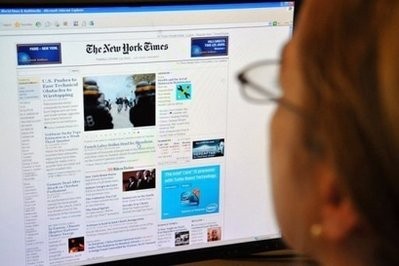WASHINGTON (AFP) – The New York Times unveiled plans to begin charging for full access to its website in a move that will be closely watched by other newspapers looking to boost online revenue.
The Times will offer readers 20 free articles a month at NYTimes.com before they will be asked to sign on to one of three digital subscription plans that cost from $15 to $35 a month.

Arthur Sulzberger, the Times publisher, announced the long-awaited move to a digital subscription model in a letter to readers published at NYTimes.com, the top US newspaper site with more than 30 million unique visitors a month.
Sulzberger said digital subscriptions will begin on Thursday in Canada to "fine-tune the customer experience" and will be extended to the United States and the rest of the world on March 28.
He said home delivery subscribers to the print edition of the Times and the International Herald Tribune, a Paris-based Times co. newspaper, will have full and free access to NYTimes.com.
Unlimited access to NYTimes.com and the newspaper's smartphone application will cost $15 for four weeks while full access to the website and a tablet computer application will cost $20 for four weeks. Full access to NYTimes.com and both smartphone and tablet applications is $35 for four weeks.
Digital subscriptions can be purchased online through NYTimes.com and will be available through Apple's iTunes by June 30.
Sulzberger said the move is a "significant transition" for the Times and "one that will strengthen our ability to provide high-quality journalism to readers around the world and on any platform."
Like other US newspapers, the Times has been struggling with declining print advertising revenue, falling circulation and the migration of readers to free news online.
The Times abandoned a previous effort to charge online called Times Select in 2007 after a two-year experiment.
The News Corp.-owned Wall Street Journal is currently the only major US newspaper charging readers for unlimited access to its website and other US publishers have been waiting for the Times to unveil its online plan.
Britain's Financial Times also charges for full online access and the managing director of FT.com, Rob Grimshaw, told AFP on Thursday that it has 210,000 digital subscribers, just over half its print circulation.
The Wall Street Journal's basic for WSJ.com is $103 a year while the Financial Times charges $249 a year for a standard FT.com subscription.
Many US newspaper publishers have been reluctant to erect pay walls around their websites out of fear that it will result in a loss of traffic and online advertising revenue.
But Grimshaw said the "metered model" used by the Financial Times and now adopted by The New York Times can work for "quality publishers."
"We feel this is an approach and a model that can work very well for quality publishers, not just in terms of niche content like business and finance news, but also for high-quality general news," he said.
"If it's high-quality content, if it's unique, if it's differentiated, then it's valuable to people and if it's valuable people will be prepared to pay," he said.
"I think you'll see a lot of other publishers adopting similar models over the next few years," Grimshaw said, although he cautioned that "it won't work for everybody."
"There's an awful lot of duplication going on across the marketplace," he said.
Dan Kennedy, a professor of journalism at Boston's Northeastern University, said the Times was taking a "smart and nuanced approach to the problem of how do you get heavy users of your online content to pay while continuing to be part of the free conversation that's taking place around your news."
Kennedy said the Times, however, is "not a very good test case for the news business as a whole" because the newspaper is "so unique."
"I really do think there's a huge base of people out there who are willing to pay for the Times and pretty much nothing else," he said.
The Times said the NYTimes.com home page and section fronts will remain free to browse and the Top News section on smartphone and tablet applications will also be free of charge.
Web users who find articles through links from Internet search, blogs and social media like Facebook and Twitter will be able to read those articles "even if they have reached their monthly reading limit," it said.
There will be a five-article a day limit, however, of free links to articles to readers who visit NYTimes.com from Google.
Times Co. shares gained 0.34 percent on Wall Street to close at $8.89.
























